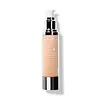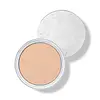What's inside
What's inside
 Key Ingredients
Key Ingredients

 Benefits
Benefits

 Concerns
Concerns

No concerns
 Ingredients Side-by-side
Ingredients Side-by-side

Aloe Barbadensis Leaf Juice
Skin ConditioningCucumis Sativus Juice
EmollientEuterpe Oleracea Fruit Oil
Skin ConditioningPunica Granatum Seed Oil
EmollientOryza Sativa Starch
AbsorbentTitanium Dioxide
Cosmetic ColorantZinc Oxide
Cosmetic ColorantPrunus Persica Fruit Extract
AbrasiveCamellia Sinensis Leaf Extract
AntimicrobialPrunus Armeniaca Fruit Extract
Skin ConditioningDaucus Carota Sativa Root Extract
Skin ConditioningPunica Granatum Extract
AstringentTheobroma Cacao Extract
Skin ConditioningLycium Chinense Fruit Extract
AntioxidantSolanum Lycopersicum Fruit/Leaf/Stem Extract
AstringentTocopherol
AntioxidantSodium Ascorbate
AntioxidantEuphorbia Cerifera Cera
AstringentRosmarinus Officinalis Leaf Extract
AntimicrobialOriganum Vulgare Leaf Extract
Skin ConditioningThymus Vulgaris Flower/Leaf Extract
MaskingLonicera Caprifolium Flower Extract
PerfumingLonicera Japonica Flower Extract
Skin ConditioningHydrastis Canadensis Extract
MaskingCinnamomum Cassia Bark
Skin ConditioningAloe Barbadensis Leaf Juice, Cucumis Sativus Juice, Euterpe Oleracea Fruit Oil, Punica Granatum Seed Oil, Oryza Sativa Starch, Titanium Dioxide, Zinc Oxide, Prunus Persica Fruit Extract, Camellia Sinensis Leaf Extract, Prunus Armeniaca Fruit Extract, Daucus Carota Sativa Root Extract, Punica Granatum Extract, Theobroma Cacao Extract, Lycium Chinense Fruit Extract, Solanum Lycopersicum Fruit/Leaf/Stem Extract, Tocopherol, Sodium Ascorbate, Euphorbia Cerifera Cera, Rosmarinus Officinalis Leaf Extract, Origanum Vulgare Leaf Extract, Thymus Vulgaris Flower/Leaf Extract, Lonicera Caprifolium Flower Extract, Lonicera Japonica Flower Extract, Hydrastis Canadensis Extract, Cinnamomum Cassia Bark
Oryza Sativa Powder
Titanium Dioxide
Cosmetic ColorantZinc Oxide
Cosmetic ColorantPrunus Persica Fruit Extract
AbrasivePrunus Armeniaca Fruit Extract
Skin ConditioningTheobroma Cacao Extract
Skin ConditioningCarica Papaya Fruit
Skin ConditioningPunica Granatum Sterols
Skin ConditioningVaccinium Macrocarpon Fruit Extract
AstringentFragaria Vesca Fruit Extract
AstringentRubus Idaeus Fruit Extract
AstringentPrunus Serotina Fruit Extract
MaskingVitis Vinifera Fruit Extract
Skin ConditioningChamomilla Recutita Leaf Extract
MaskingCalendula Officinalis Flower Extract
MaskingCamellia Sinensis Leaf Extract
AntimicrobialEucalyptus Globulus Leaf Powder
AbrasiveLinum Usitatissimum Seed Flour
AbrasiveRosa Damascena Flower Extract
MaskingPunica Granatum Seed Extract
Skin ConditioningPersea Gratissima Leaf Extract
Skin ConditioningMica
Cosmetic ColorantTocopherol
AntioxidantCitral
PerfumingEugenol
PerfumingGeraniol
PerfumingCitronellol
PerfumingFarnesol
PerfumingLinalool
PerfumingOryza Sativa Powder, Titanium Dioxide, Zinc Oxide, Prunus Persica Fruit Extract, Prunus Armeniaca Fruit Extract, Theobroma Cacao Extract, Carica Papaya Fruit, Punica Granatum Sterols, Vaccinium Macrocarpon Fruit Extract, Fragaria Vesca Fruit Extract, Rubus Idaeus Fruit Extract, Prunus Serotina Fruit Extract, Vitis Vinifera Fruit Extract, Chamomilla Recutita Leaf Extract, Calendula Officinalis Flower Extract, Camellia Sinensis Leaf Extract, Eucalyptus Globulus Leaf Powder, Linum Usitatissimum Seed Flour, Rosa Damascena Flower Extract, Punica Granatum Seed Extract, Persea Gratissima Leaf Extract, Mica, Tocopherol, Citral, Eugenol, Geraniol, Citronellol, Farnesol, Linalool
 Reviews
Reviews

Ingredients Explained
These ingredients are found in both products.
Ingredients higher up in an ingredient list are typically present in a larger amount.
Camellia Sinensis Leaf Extract is derived from the leaves of the tea plant. Black tea, green tea, and oolong tea are all harvested from this plant.
This ingredient has many skin benefits:
This ingredient contains polyphenols, a strong antioxidant. Antioxidants help fight off molecules that damage skin cells.
On top of that, the antioxidants in green tea neutralize free-radicals from the sun. This gives the skin some extra UV protection, but should not replace sunscreen.
Many components of tea have anti-inflammatory properties.
Polyphenols and L-theanine help soothe the skin and reduce irritation. The caffeine in Camellia Sinensis Leaf Extract helps calm inflamed blood vessels.
Other compounds found in tea include: Vitamin Bs, linoleic acid, magnesium, calcium, iron, and zinc.
Research has shown both drinking Camellia Sinensis Leaf Tea and applying it to the skin can help boost skin elasticity and hydration. Studies also show using tea extract may reduce sebum, or oil, production.
Learn more about Camellia Sinensis Leaf ExtractThis ingredient is also known as apricot extract. It has skin conditioning properties and is rich in vitamins and minerals.
Prunus Persica Fruit Extract comes from peaches.
Peaches are rich in antioxidants, such as Vitamins C, E and A. Antioxidants help reduce the signs of aging. These vitamins also have plenty of skin benefits on their own (for instance, Vitamin C, E helps with skin brightening).
Peach extract is also an abrasive. Abrasives are an agent used to wear away the surface of skin. They are used to help polish or exfoliate skin.
Emerging research shows Peach extract may help protect UV-B induced skin damage. However, further research is needed.
Learn more about Prunus Persica Fruit ExtractThis ingredient is extracted from the seeds of the cocoa tree.
Cacao seeds contain antioxidants known as polyphenols. These include flavonoids, procyanidins, and epicatechins.
Studies show these polyphenols help improve skin health.
The more famous ingredient from cocoa tree is cocoa butter.
Learn more about Theobroma Cacao ExtractTitanium dioxide is a mineral UV filter widely used in sunscreens and cosmetics.
It is one of only two UV filters officially classified as “mineral” by regulatory agencies, the other being zinc oxide.
Titanium dioxide provides broad-spectrum protection mostly in the UVB and UVAII range, with some protection in the UVAI range.
While its UVA protection isn’t as strong as zinc oxide’s, the difference is minor.
A common myth is that mineral UV filters reflect UV light. However, modern research shows titanium dioxide absorbs UV radiation like chemical filters (~95% absorption & 5% reflection).
Thanks to its non-irritating nature, titanium dioxide is suitable for sensitive, acne-prone, or redness-prone skin. It is unlikely to cause "eye sting" like other sunscreen ingredients.
A major drawback of this ingredient is its white cast and thick texture. This is why mineral sunscreens often leave a white cast and are less cosmetically elegant than chemical/hybrid sunscreens.
To improve white cast and spreadability, micronized or nano-sized titanium dioxide is often used.
There are ongoing concerns surrounding nano-titanium oxide's impact on marine ecosystems.
There is no conclusive evidence that any form of titanium oxide (or any other sunscreen ingredients) will cause harm to marine ecosystems or coral reefs. The science is still developing but many consumers are keeping a close eye on this issue.
Please note, many destinations have reef-safety sunscreen rules. For instance, the U.S. Virgin Islands advises all visitors to use non-nano mineral sunscreens.
Nano mineral sunscreens once raised safety concerns about absorption into skin.
Extensive research has shown that they do not penetrate healthy or damaged skin; they remain safely on the surface and the top layer of dead skin (stratum corneum).
You'll likely find titanium dioxide bundled with alumina, silica, or dimethicone. These ingredients help make titanium dioxide highly photostable; this prevents it from interacting with other formula components under UV light.
Learn more about Titanium DioxideTocopherol (also known as Vitamin E) is a common antioxidant used to help protect the skin from free-radicals and strengthen the skin barrier. It's also fat soluble - this means our skin is great at absorbing it.
Vitamin E also helps keep your natural skin lipids healthy. Your lipid skin barrier naturally consists of lipids, ceramides, and fatty acids. Vitamin E offers extra protection for your skin’s lipid barrier, keeping your skin healthy and nourished.
Another benefit is a bit of UV protection. Vitamin E helps reduce the damage caused by UVB rays. (It should not replace your sunscreen). Combining it with Vitamin C can decrease sunburned cells and hyperpigmentation after UV exposure.
You might have noticed Vitamin E + C often paired together. This is because it is great at stabilizing Vitamin C. Using the two together helps increase the effectiveness of both ingredients.
There are often claims that Vitamin E can reduce/prevent scarring, but these claims haven't been confirmed by scientific research.
Learn more about TocopherolZinc Oxide is a mineral broad-spectrum UV filter; it is the broadest UVA and UVB reflector approved by the FDA. It also has skin protectant and skin soothing properties.
Zinc oxide is one of the most effective broad-spectrum UV filters. It protects against UVB, UVAII, and UVAI. In comparison to its counterpart titanium dioxide, zinc oxide provides uniform and extended UVA protection.
Another great benefit? This ingredient is highly photostable so it won't degrade easily under sunlight.
A common myth is that mineral UV filters are widely believed to primarily reflect UV light.
However, modern research shows titanium dioxide absorbs UV radiation like chemical filters (~95% absorption & 5% reflection).
Zinc oxide has great skin soothing properties so you'll likely find this in sunscreens formulated for sensitive skin or babies/children. It is unlikely to cause "eye sting" like other sunscreen ingredients.
Regulatory agencies consider zinc oxide to be non-toxic and safe. It has also been shown to not penetrate the skin.
Unfortunately, this ingredient does leave a visible white cast. This is why mineral sunscreens are often less cosmetically elegant than chemical or hybrid ones.
In cosmetics, zinc oxide can be found in both non-nano and nano-sized forms. The nano version is used to reduce white cast and improve the texture of sunscreen formulas.
There are ongoing concerns surrounding nano-zinc oxide's impact on marine ecosystems and whether it can be absorbed into skin.
Regarding marine ecosystems and coral reefs, there is no conclusive evidence that any form of zinc oxide (or any other sunscreen ingredients) will cause harm. The science is still developing but many consumers are keeping a close eye on this issue.
Please note, many destinations have reef-safety sunscreen rules. For instance, the U.S. Virgin Islands advises all visitors to use non-nano mineral sunscreens.
There has also been some stir about whether micronized or nano zinc oxide has potential photoxicity and absorption through the skin/lungs.
An in-vitro (done in a test tube or petri dish) study demonstrated micronized zinc oxide to have potential phototoxicity. There's no need to fret; the EU Commission's Scientific Committee on Consumer Safety has stated, "The relevance of these findings needs to be clarified by appropriate investigations in vivo." Or in other words, further studies done on living organisms are needed to prove this.
Current research shows zinc oxide nanoparticles do not penetrate intact or sunburned skin. They either remain on the surface or in the outermost layer of dead skin (stratum corneum).
Zinc oxide is one of only two classified mineral UV filters with titanium dioxide being the other one.
Fun fact: Zinc has been used throughout history as an ingredient in paint and medicine. An Indian text from 500BC is believed to list zinc oxide as a salve for open wound. The Ancient Greek physician Dioscorides has also mentioned the use of zinc as an ointment in 1AD.
Learn more about Zinc Oxide